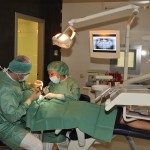
Periapical pathology may persist even after conventional root canal therapy and periapical surgery may be the last option prior to tooth extraction. Large periapical lesions can also fail to resolve completely. With the introduction of regenerative techniques such as guided tissue or bone regeneration into periodontology and implant dentistry the use of these techniques as an adjunct to periapical surgery has been advocated.
The aim of this review was to evaluate the effect of regeneration techniques (RTs) on the outcome of periapical surgery with different protocols for different lesion types.
Methods
Searches were conducted in the Medline/PubMed, Embase and Cochrane library databases . Controlled trials of regenerative techniques in patients having periapical surgery for failed orthograde root canal therapy in which periapical radiolucency was present with a follow up period of at least 1 year were considered.
Two reviewers independently selected studies, abstracted data and assessed risk of bias using the he Cochrane risk of bias tool. Meta-analysis was performed with the tooth as the unit of analysis.
Results
- 8 studies were included.
- 2 studies were considered to be a low risk of bias and 6 at moderate risk.
- A significantly better outcome was found in:-
- Combination group (membranes plus bone replacement analogues), risk ratio [RR] =0.41 (95% CI; 0.22 to 0.77; P = .005) and
- Bone replacement analogue–only group, RR =0.48;(95% CI; 0.23 to 0.98; P = .04),
- No significant beneficial effect was found in the membrane-only group RR = 0.59 (95% CI; 0.29 to 1.17; P = .13).
- Regeneration techniques favorably affected the outcome of:-
- Periapical through-and-through lesions, RR = 0.38 (95% CI; 0.18 to 0.84; P = .02) and
- Large lesions (≥ 10 mm), RR =0.52 (95% CI; 0.28 to 0.97; P = .04).
- There was no significant benefit of using RTs for 4-wall lesions, RR= 0.54 (95% CI; 0.27 to 1.07; P = .08).
Conclusions
The authors concluded
Both the isolated use of bone replacement analogues and the combination of membranes and bone replacement analogues can improve the outcome of periapical surgery, whereas using membranes alone does not have significantly favorable effects. The use of RTs for through-and-through and large lesions should be recommended.
Comments
While the results of this review suggest benefits form the use of regenerative techniques for periapical lesions the author do suggest that their findings are interpreted with caution. The included studies are small with several being conducted by the same groups of researchers and while several meta-analysis have been conducted they only involve between 2-4 studies in each analysis.
Links
Primary paper
Deng Y, Zhu X, Yang J, Jiang H, Yan P. The Effect of Regeneration Techniques on Periapical Surgery With Different Protocols for Different Lesion Types: A Meta-Analysis. J Oral Maxillofac Surg. 2016 Feb;74(2):239-46. doi: 10.1016/j.joms.2015.10.007. Epub 2015 Oct 23. Review. PubMed PMID: 26546842.

Improved periapical surgery outcomes with regenerative techniques? https://t.co/dHm0V40ZZb
Periapical surgery – improved outcomes with regenerative techniques? https://t.co/dHm0V40ZZb
Better periapical surgery outcomes with adjunctive regenerative techniques? https://t.co/dHm0V40ZZb
Periapical surgery-better outcomes with regenerative techniques? https://t.co/dHm0V40ZZb
Review suggests better periapical surgery outcomes with adjunctive regenerative techniques? https://t.co/dHm0V40ZZb
Don’t miss- Periapical surgery – improved outcomes with regenerative techniques? https://t.co/dHm0V40ZZb